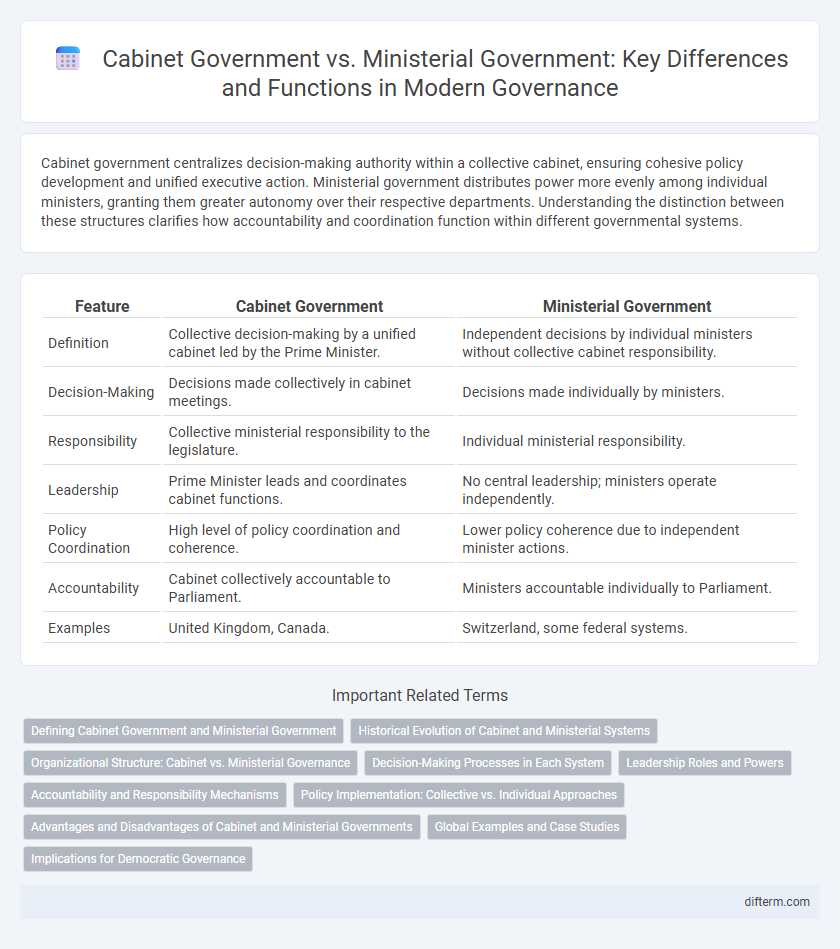Cabinet government centralizes decision-making authority within a collective cabinet, ensuring cohesive policy development and unified executive action. Ministerial government distributes power more evenly among individual ministers, granting them greater autonomy over their respective departments. Understanding the distinction between these structures clarifies how accountability and coordination function within different governmental systems.
Table of Comparison
| Feature | Cabinet Government | Ministerial Government |
|---|---|---|
| Definition | Collective decision-making by a unified cabinet led by the Prime Minister. | Independent decisions by individual ministers without collective cabinet responsibility. |
| Decision-Making | Decisions made collectively in cabinet meetings. | Decisions made individually by ministers. |
| Responsibility | Collective ministerial responsibility to the legislature. | Individual ministerial responsibility. |
| Leadership | Prime Minister leads and coordinates cabinet functions. | No central leadership; ministers operate independently. |
| Policy Coordination | High level of policy coordination and coherence. | Lower policy coherence due to independent minister actions. |
| Accountability | Cabinet collectively accountable to Parliament. | Ministers accountable individually to Parliament. |
| Examples | United Kingdom, Canada. | Switzerland, some federal systems. |
Defining Cabinet Government and Ministerial Government
Cabinet government refers to a system where collective decision-making is centralized in a cabinet composed of senior ministers, ensuring unified executive authority. Ministerial government emphasizes individual ministers' responsibility for specific departments, granting them autonomy in policy implementation and administration. These models differ in the balance of power between collective cabinet decisions and individual ministerial control.
Historical Evolution of Cabinet and Ministerial Systems
The cabinet government system emerged in the 18th century Britain, evolving from royal councils into a collective decision-making body led by the Prime Minister, thereby enhancing executive coordination and parliamentary accountability. In contrast, the ministerial government system traces back to continental Europe, characterized by ministers acting independently under the monarch's authority without a unified cabinet structure. The historical evolution reflects shifting power dynamics from monarch-centric governance to more collaborative and institutionalized forms of political leadership.
Organizational Structure: Cabinet vs. Ministerial Governance
Cabinet government features a collective decision-making body composed of senior ministers collectively responsible for policy, ensuring coordinated governance across departments. Ministerial government emphasizes individual ministers' autonomy over their portfolios, allowing for specialized focus but potentially reducing interdepartmental cohesion. The organizational structure in cabinet government promotes unified policy direction, whereas ministerial governance supports decentralization and individual accountability.
Decision-Making Processes in Each System
In a cabinet government, decision-making processes involve collective deliberation where the entire cabinet shares responsibility, promoting unified policy outcomes and ensuring that major decisions reflect a broad consensus among ministers. Ministerial government centers decision-making authority within individual ministers who exercise control over their departments, allowing for specialized and swift policy implementation but potentially leading to fragmented government actions. The distinction significantly impacts governance efficiency, accountability mechanisms, and the coherence of public policy across administrative sectors.
Leadership Roles and Powers
In a cabinet government, leadership roles are centralized within the cabinet collectively, where the prime minister coordinates policy decisions while individual ministers head their departments but share collective responsibility. Ministerial government emphasizes decentralized leadership, granting ministers significant autonomy and authority over their portfolios without requiring unanimous cabinet consensus. This structural distinction impacts the distribution of executive powers, influencing how policies are formulated and implemented across government sectors.
Accountability and Responsibility Mechanisms
In a cabinet government, accountability is collective, with the entire cabinet held responsible for policy decisions, ensuring unified government action and shared responsibility before the legislature. Ministerial government emphasizes individual ministerial responsibility, where each minister is accountable for their department's performance and decisions, promoting direct accountability to the parliament and the public. These mechanisms influence how policies are implemented and how governments maintain transparency and answerability to legislative bodies.
Policy Implementation: Collective vs. Individual Approaches
In cabinet government, policy implementation relies on a collective decision-making process where responsibilities are shared among cabinet members, ensuring coordinated and unified actions. Ministerial government emphasizes individual ministers holding autonomous authority over their departments, leading to decentralized and specialized policy execution. This divergence influences the efficiency and consistency of government policies based on the degree of collaboration or independence within the executive branch.
Advantages and Disadvantages of Cabinet and Ministerial Governments
Cabinet government centralizes decision-making authority within the collective cabinet, promoting unified policies and coherent governance, but risks groupthink and slower response times due to the need for consensus. Ministerial government assigns individual ministers responsibility for specific departments, enhancing accountability and specialized expertise while potentially causing fragmented policy and inter-ministerial conflicts. Both structures balance efficiency and coordination differently, affecting governmental stability and policy implementation effectiveness.
Global Examples and Case Studies
Cabinet government is exemplified by the United Kingdom, where collective decision-making by the Prime Minister and cabinet ministers drives policy, ensuring unified governance. Ministerial government appears in countries like the United States, emphasizing individual ministerial responsibility and autonomy in departmental management. Comparative case studies reveal that cabinet government fosters coordinated national strategies, while ministerial government supports specialized, decentralized administration across sectors.
Implications for Democratic Governance
Cabinet government centralizes collective decision-making among senior ministers, promoting unified policy direction and accountability within democratic institutions. In contrast, ministerial government emphasizes individual ministerial responsibility and autonomy, potentially enhancing specialized governance but risking fragmented policy coherence. The choice between these models significantly influences democratic governance by balancing the need for coordinated leadership with ministerial independence and transparency.
cabinet government vs ministerial government Infographic

 difterm.com
difterm.com